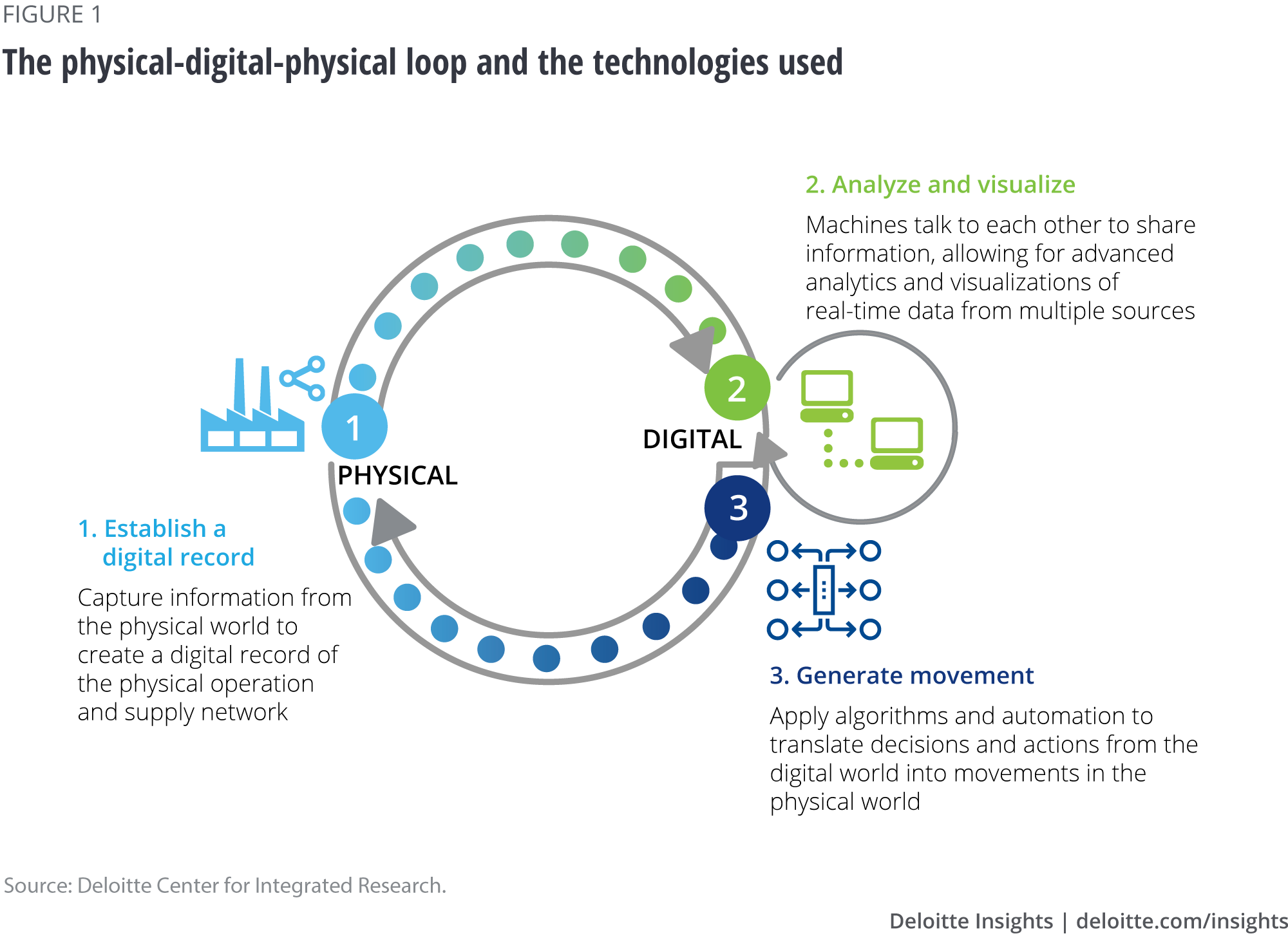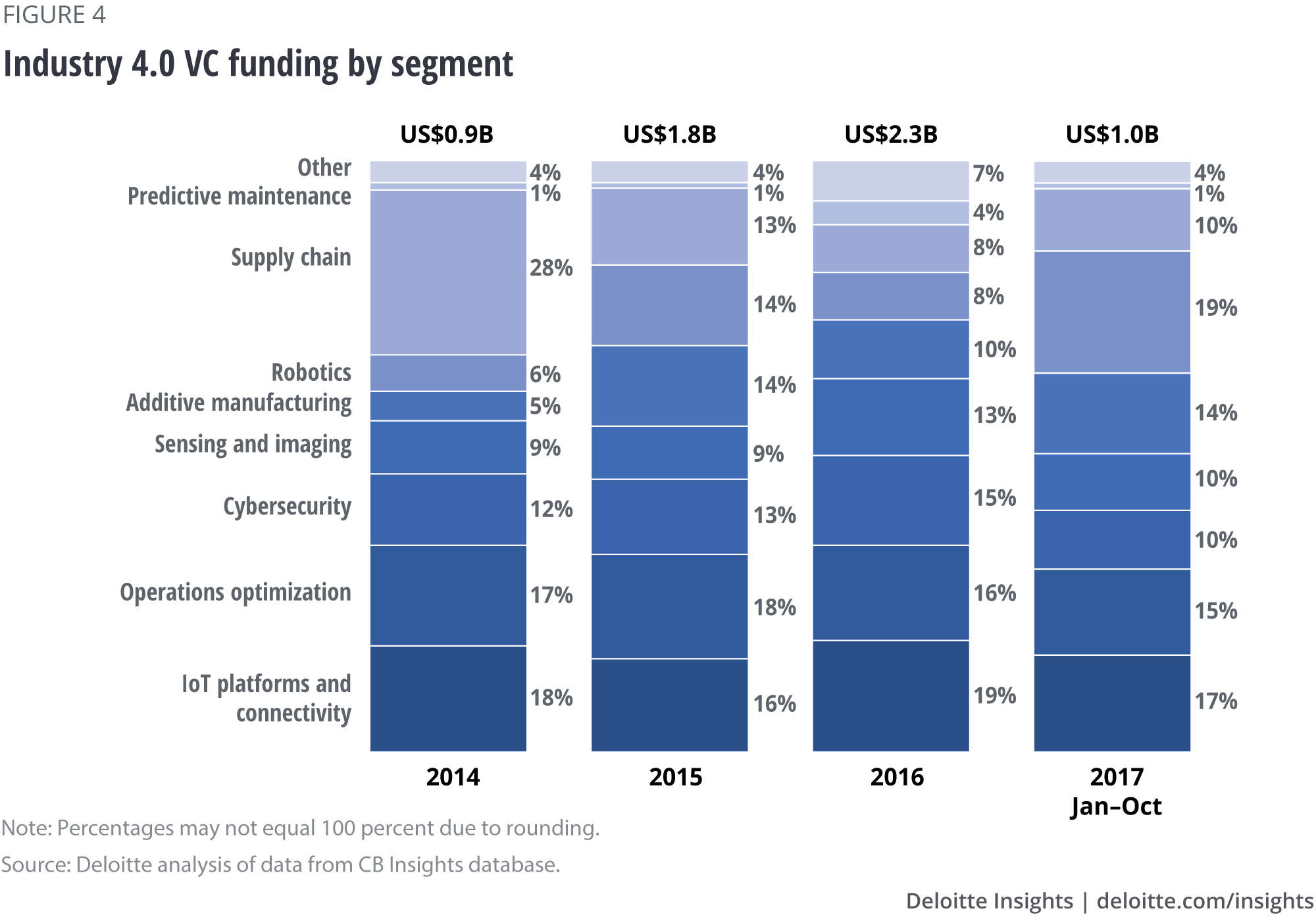
Toward the next horizon of Industry 4.0 Building capabilities through collaborations and startups
02 August 2018
As established companies evaluate how Industry 4.0 can best help them with such transformative actions as optimizing processes and creating new business models, they could benefit by looking externally to collaborations and startups for solutions.
Introduction
We appear on the cusp of a fourth Industrial Revolution, also known as Industry 4.0. Enabled by the concurrent development and integration of digital and physical technologies, Industry 4.0 could transform the manufacturing ecosystem—and many other sectors and industries beyond (see the sidebar “What is Industry 4.0?” to learn more).
Learn More
Explore the Industry 4.0 Collection
Watch the Deloitte and MIT Sloan Management review series, Following the digital thread
Subscribe to receive related content
As these waves of change reshape the competitive landscape, organizations should think strategically when determining where to focus and invest, to build their capabilities. Depending on their strategic objective, manufacturers can decide which Industry 4.0 technology they wish to adopt across multiple objectives and horizons of maturity. It is often very difficult, however, to build these new advanced capabilities from the ground up. With this in mind, organizations can look externally for solutions, by collaborating with external partners or investing in startups with the relevant expertise.
While collaborations in general can bring benefits to all sides, enabling each to gain from the expertise of the other, collaborating with startups can be particularly valuable: Often more nimble and open to untested approaches, startups can provide unique opportunities to start down the path toward innovation—or dive deeper into an already-initiated digital transformation. This can play a crucial role in offering some unique and diverse solutions that help define this fourth Industrial Revolution.
To gain a better understanding of some of the pressing needs of manufacturers and various ways in which collaborations in general—and startups in particular—can provide value across multiple horizons of Industry 4.0 maturity, Deloitte Israel developed a maturity mapping of Industry 4.0 applications across three horizons. Deloitte Israel also conducted global research, including 34 qualitative interviews with executives of leading manufacturers in Europe and the United States, global industry leaders, and those with global Industry 4.0 expertise; gathered and analyzed hundreds of use cases; and performed meta-analysis of Industry 4.0 publications, initiatives, and investment activities. The research takes a global perspective to examine which capabilities it seems manufacturers wish to prioritize and where they fit along the horizons of Industry 4.0 implementation and usage. This, in turn, suggests strategies for how to maximize shared value across Industry 4.0 horizons through collaboration with partners and startups.
What is Industry 4.0?
The concept of Industry 4.0 incorporates and extends digital connectivity within the context of the physical world in digital enterprises and digital supply networks. This drives the physical act of manufacturing, distribution, and performance in an ongoing cycle known as the physical-digital-physical (PDP) loop (figure 1).
Industry 4.0 technologies combine digital information from many different physical and digital sources and locations, including the Internet of Things (IoT) and analytics, additive manufacturing, robotics, high-performance computing, artificial intelligence and cognitive technologies, advanced materials, and augmented reality.
Throughout this cycle, real-time access to data and intelligence is driven by the continuous and cyclical flow of information and actions between the physical and digital worlds. Many manufacturing and supply chain organizations already have some portions of the PDP loop in place, namely, the physical-to-digital, and digital-to-digital processes. However, it is the leap from digital back to physical—from connected, digital technologies to action in the physical world—that constitutes the essence of Industry 4.0.1

For further information, see Forces of change: Industry 4.0 and Industry 4.0 and manufacturing ecosystems: Exploring the world of connected enterprises.
Entry points into Industry 4.0: Journeying from implementation to maturity
Industry 4.0 technologies can add value to both the top and bottom line, simultaneously. However, Deloitte’s body of Industry 4.0 research has shown that many manufacturers typically focus on either cutting costs or generating revenue.2 Today, the majority of manufacturers are implementing Industry 4.0 technologies to improve a specific process or solve a specific pain point, but as these technologies become increasingly advanced and leaders grow more facile and familiar with use cases for the technologies, many organizations are beginning to make the transition toward more holistic solutions. This transition can be divided into three horizons of Industry 4.0 maturity.
Three horizons of Industry 4.0
Manufacturers seeking entry into an integrated system require a basic level of connectivity. Once this connectivity is established, they can begin the journey toward integrating digitalization processes. This typically occurs in three different horizons: process optimization, process flow and quality, and new business models (see figure 2).

- Process optimization. In this phase, companies look inward to improve current processes. Initiatives in this phase typically target a specific need and have a clearly visible ROI. These types of activities can represent the easiest step for organizations to take, as they represent cost savings, rather than the uncertainty of new processes.3 For example, solutions in this horizon include predictive maintenance4 of machinery and utilization of data5 for production process improvements. This generally requires a basic level of connectivity to enable data collection and analysis; however, it can be limited in scope. Thus, these solutions tend to be easier to implement as they represent a limited number of technologies targeting a specific issue. Further, they generally do not face as many of the organizational challenges or technological barriers that can arise when organizations try to link multiple different legacy systems in larger, cross-functional initiatives.
- Process flow and quality. Companies working on the second horizon increase their level of connectivity to improve process flow and upgrade quality. In this phase, organizations can seek to evolve their supply chains toward digital supply networks,6 in which information flows throughout all stages of the interconnected value chain, enabling greater responsiveness and more informed decision-making. For instance, sales data can be collected and analyzed, then automatically transferred to sourcing and manufacturing systems; suppliers can more effectively connect to manufacturers’ systems for dynamic responses to shifts in supply and demand. Unlike the first horizon, more technological and organizational shifts are generally required, as well as a more critical imperative for systemwide connectivity. Further, benefits can take longer to realize, and can come with significant upfront investments.
- New business models. In the third horizon, new business models are created. This can consist of new products, increased product personalization, or entirely new revenue models. For example, driven by strong demand from clients, many original equipment manufacturers (OEMs) are adding smart equipment into their portfolio, and some are even attempting to use these products to pivot from being a supplier to a service provider.7 While a great deal of companies can agree that truly transformative value lies in this horizon, many still struggle to formulate how to successfully realize an effective model.
It is important to note that while these horizons tend to be progressive, they are not mutually exclusive; companies that have progressed to the second horizon can also have activities in the first horizon.
Regardless of the mode of the implementation and the horizon in which initiatives fall, Industry 4.0 can have a strong impact, potentially boosting several performance indicators, including lower maintenance costs, decreased downtime, savings in inventory costs, gains in labor productivity, accelerated production time, and savings related to improved ability to predict outcomes. Indeed, one executive interviewed noted that, by adopting sensors and adaptive control technology, his organization was able to reduce cycle times by 30 percent.8 When it comes to implementing Industry 4.0 within these three horizons, manufacturers and suppliers seek the right technologies in which to invest, to obtain these types of benefits.
Given their tangible results, initiatives with a clear link to ROI—or the first horizon, process optimization—have typically been easier for manufacturers to adopt. And, in fact, research has shown that operations and processes are the top areas for focus for Industry 4.0 initiatives.9 Indeed, based on Deloitte Israel’s analysis of 80 different Industry 4.0 use cases, approximately 50 percent of the time Industry 4.0 was implemented to optimize processes and reduce costs. Roughly 35 percent of the cases were targeted to improve the process quality and efficiency, and about 15 percent of cases directly improved the top line.
Which Industry 4.0 capabilities are generally the most sought after?
Manufacturers can incorporate a variety of Industry 4.0 solutions across all three horizons. The Israeli NGO Start-up Nation Central10 has identified 10 different segments in which Industry 4.0 solutions can be categorized throughout each of the three horizons (see figure 3). Of these 10 categories, some are deemed by manufacturers as the most important in the current business environment; others are deemed more pressing for future development. Deloitte Israel conducted 34 qualitative interviews with global corporations and global leaders with Industry 4.0 expertise to understand which solutions they plan to prioritize. The two main areas identified by the interviewees as most important in the current business environment are:
- Predictive maintenance solutions decrease unplanned downtime, one of the greatest costs to manufacturers, which improves asset utilization and boosts the bottom line.
- Operations optimization provides new ways to increase productivity and reduce operating costs by improving processes (a longtime focus of manufacturers).
Understanding which segments are top of mind can help organizations determine in which segments or capabilities to invest or form partnerships. As companies continue to move from the first horizon of process optimization into the second horizon of process flow and quality—one that requires greater levels of connectivity and increased volumes of data—they often face issues of data collection and protection. Therefore, two areas will likely gain greater importance in the future with the transition to fully connected systems:
- Sensing and imaging. As Industry 4.0 progresses, the need for technologies capable of collecting more actionable data, both in terms of quality and scale, could increase.
- Cybersecurity. As connectivity becomes more advanced and ubiquitous, the threat from cyberattacks is expected to grow. Because of this, many companies are hesitant about developing greater connectivity until more protective systems are in place.

Building Industry 4.0 capabilities: Looking outside the organization
As organizations look across the myriad opportunities and solutions within each Industry 4.0 implementation horizon, it can be challenging to build the capabilities to harness them. It can certainly feel insurmountable—in terms of time and cost—to build those capabilities from the ground up. Organizations seeking to build and evolve Industry 4.0-driven capabilities that are more advanced or mature—or gain hard-won wisdom gained through experience—can look to several avenues beyond building it themselves: collaborating with external partners, or investing in startups with the relevant expertise.
Capabilities through collaboration
Collaborations are becoming increasingly common as companies begin to recognize the benefits of a shared pool of complementary knowledge and capabilities (see sidebar, “Collaboration in action”). Organizations possess a range of options in a large ecosystem of different types of players with whom they can collaborate, and from whom they can learn. Indeed, there are many actors, and a spectrum of capabilities.
To understand how to identify the sources creating the most value for the Industry 4.0 ecosystem, it is important to examine the types of players involved and how they interact. Industry 4.0-driven players can be categorized into five key segments, described below. Depending on their needs, organizations may seek out partners from specific segments.
- Platform players offer products that facilitate communication between digital and physical infrastructures. These platforms span the entire system to collect and analyze data from industrial machines.11 Developers can create applications for these platforms to analyze the collected data and provide users with actionable insights.
- OEMs sell production equipment to manufacturers of end products. These players can implement Industry 4.0 in their own manufacturing processes and can also use these technologies to create smart products for their customers. This presents OEMs with a unique opportunity to adopt new business models, giving them the ability to go from being an equipment supplier to an ongoing service provider. For example, a leading equipment manufacturer made a strategic decision to put a strong focus on Industry 4.0 opportunities and is offering its customers IoT integrated smart control parts. They now offer a full part performance package which enables possible faults to be detected and removed at an early stage as well as through proactive maintenance management.12
- Manufacturers may have the most complex job. They not only need to anticipate changing consumer needs, but must also simultaneously optimize current production capabilities while seeking new technologies adaptable to future trends.
- Integrators consult on how to design, implement, and collaborate on the development of smart solutions in order to bring the most value. These players are highly familiar with different solutions on the market and industry best practices. Thus, they can help manufacturers embrace, implement, and manage the transformation to Industry 4.0 capabilities.
- Startups or other technology providers developing new enabling technologies, such as sensors, machine learning, augmented reality, and others. Generally speaking, these are the most focused companies that address specific problems in order to create value-added solutions.
While most companies must consider various options for collaboration to successfully compete in today’s manufacturing environment, this last category in particular—startups—can serve as particularly effective and innovative partners. Four out of every five corporations interviewed by Deloitte Israel already work with startups in Industry 4.0 and view them as an integral piece to their continued innovation efforts.
Collaboration in action
While many companies may still have an incomplete understanding of Industry 4.0 technologies, and can feel unsure of where to begin, collaborations can help companies to gain expertise, scale more quickly, or benefit from the skills and capabilities of their partners—while sharing their own unique expertise so that all parties see value.
One such example is the partnership of five different types of players: a chemical manufacturer along with providers of equipment, sensor technology, and platforms. Together, these companies, each bringing their own unique capabilities, have developed a platform that gathers data on the condition of devices and components involved in the manufacturing process to define maintenance activities.13
While these large-scale, multiplayer collaborations can create value, other companies are choosing to make more straightforward partnerships with a single provider, whether to solve a specific problem or create long-term value. In another example, Enel, an Italian electric and gas provider, has teamed with an Israeli startup, 3DSignals, to predict and fix problems within their plants before they occur. 3DSignals developed a solution that uses sensors to monitor machines for changes in acoustic levels in order to predict anomalies. This collaboration has allowed Enel to fix problems without stopping the entire plant's production and has enabled their technicians to monitor situations remotely via a mobile application. Following a successful test run in its hydroelectric plants in Italy and Spain, Enel plans to roll out this technology to all of its plants.14
Capabilities through startups
Startups can bring unique added value in several ways. First, startups can offer increased flexibility and customization to manufacturers. Moreover, the services offered by startups are often priced significantly lower than those offered by more established companies. Additionally, startups often comprise a multidisciplinary team of entrepreneurs who have both worked on developing the technology and implementing it, enabling them to provide end-to-end solutions. Finally, given their smaller size, startups can be more agile and responsive to changes in the ecosystem, and able to adapt to larger platforms as well as to individualized needs of clients.15 Due to these and other benefits, Industry 4.0 startups are seeing strong investment growth across the 10 capabilities we’ve explored in this article (see the sidebar “Venture capital funding for Industry 4.0 startups, and Israel’s growing role” to learn more).
Of the 10 capabilities, the segments that have most consistently raised the largest amount of venture capital (VC) funding from multiple deals since 2014 are IoT platforms and connectivity, cybersecurity, sensing and imaging, and operations optimization. These four segments received approximately 60 percent of the total US$6.6 billion raised from VCs, globally in this period (see figure 4). Value seems to be clearly created by many startups, particularly in many organizations’ priority areas such as operations optimization, while most are also anticipating future needs in cybersecurity and sensing and imaging.

Venture capital funding for Industry 4.0 startups, and Israel’s growing role
As Industry 4.0 technologies have become more prevalent and the number of startups active in the Industry 4.0 arena has increased, VC investments have risen accordingly. Indeed, VC investments in Industry 4.0-focused startups—specifically, those geared toward each of the 10 solutions—have steadily increased, both in terms of size and number of deals. Globally, venture capital investments in this arena grew from approximately US$600 million in 2014 to US$2.3 billion in 2016, representing a 40 percent CAGR.16
Often referred to as the “Silicon Wadi”17 or the “Startup Nation,” Israel has the highest number of active startups per capita globally.18 Although Israel’s manufacturing sector is relatively small, local innovators appear to have taken notice of the need for new tech-based solutions and have begun to develop products based around the competencies of cybersecurity, analytics, and sensing and imaging. As such, Israel is quickly becoming a hub of innovation for Industry 4.0, having received 10 percent of global VC funding in 2016.19
Israel is home to nearly 200 companies focused on innovative Industry 4.0 solutions, many of which have successfully raised significant funds. These startups have been attracting corporate VC attention from leading Industry 4.0 companies.
Getting started: Start small, think big
The technological advancements brought on by Industry 4.0 have disrupted the ways in which business is conducted. Companies, especially manufacturers, should actively seek to enhance their systems and products to remain competitive. No longer will problems likely be solved simply by looking inward, but rather by tapping into the expertise of others, forming partnerships to create new and innovative solutions. In particular, collaborations with startups could add value by implementing their innovations throughout a multitude of points along the value chain.
As organizations seek to evolve along Industry 4.0 horizons and adopt a series of new Industry 4.0 driven capabilities to improve their organizations, they can consider the following:
- Start with small steps. It is important to remember that the transition into tomorrow’s manufacturing industry will likely be a metamorphosis, and not a quantum leap. Many companies are still in the first horizon of implementation, which is a necessary step in order to acquire the knowledge and capabilities required before reaching higher levels of implementation. Leveraging the knowledge and expertise of startups, however, can help companies take those initial steps.
- Pilot developing solutions. If manufacturers and startups collaborate on piloting a new product, this type of collaboration could be mutually beneficial: Manufacturers get access to a technology as it is developed, and startups find a reputable corporation with which to pilot and develop their product. In this scenario, manufacturers need only to set aside limited resources to implement these pilots, but can still reap the benefits.
- Designate an innovation officer. Establishing a dedicated function for scouting and onboarding innovative solutions can be an efficient way for manufacturers to drive forward their capabilities and remain competitive. This doesn’t necessarily mean manufacturers need to establish a team of employees to source and implement solutions, but can take the form of a single employee who takes responsibility to connect with innovative ecosystems and serve as an internal champion for implementation of new solutions—even those solutions that may exist outside the organization.
- Develop innovation partnerships. As your organization begins to implement solutions and become comfortable working with connected machinery, consider continuing to learn about technological advancements and how they can be integrated within your organization. Try to keep an open dialogue about issues your company faces with startups and innovative ecosystems with which it is connected. Perhaps someone has already solved the problem your organization is facing, or knows how to solve it for you.
- Invest in the future. Aside from directly incorporating Industry 4.0 technologies into their operations, organizations should consider investing in startups that are aligned with their strategy or goals. Such investments could not only provide them with a unique financial opportunity to guide the startup to an exit, but also would give them access to the startup’s innovation, and could provide them with the ability to aid and influence the startup in a way that would be mutually beneficial.
While the future of technology could bring a great deal of change and uncertainty, it is ultimately in the hands of business leaders to challenge their companies and, in the process, move them forward by building new alliances, implementing creative solutions, working with and investing in startups, and, ultimately, harnessing the potential of Industry 4.0 to take them toward the next horizon.
© 2021. See Terms of Use for more information.






